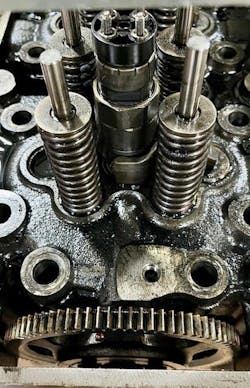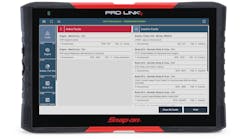Stringent greenhouse gas emissions regulations over the past decade are impacting future lubricant technologies. The American Petroleum Institute is developing PC-12, its latest heavy-duty engine oil category, to support original equipment manufacturers' efficiency developments. The first licensing of oils under the new standard is targeted for January 1, 2027.
PC-12 is being designed for two subcategories: PC-12A, which will be backward compatible with previous specifications, and PC-12B, which may have different viscosity and soot control capabilities. The oils will feature tighter chemical limits for phosphorous, sulfur, and sulfated ash to protect advanced aftertreatment systems.
"The second new PC-12 category will offer additional benefits based on lower high-temperature high shear oil viscosity," said Darryl Purificati, senior technical adviser at Petro-Canada Lubricants, an HF Sinclair brand, and chair of the American Petroleum Institute. "API is also creating two separate subcategories of HTHS oils as part of PC-12 to meet the diverse needs of OEMs. By having two options available, OEMs using specific hardware architecture will be able to take advantage of lower HTHS oils."
According to Purificati, the second HTHS subcategory will offer even lower viscosity grades, including SAE 0W-20s, while still providing outstanding durability and wear protection, further reducing viscous drag to improve overall fuel economy.
"PC-12 is expected to continue the journey toward lower viscosity oils while maintaining durability and improving performance," Purificati said. "Using the latest lubricant technology, these oils will contribute to improved fuel economy and reduced carbon emissions for fleets, supporting efforts to reduce greenhouse gas emissions."
"Introducing low-viscosity engine oils is an effective but often overlooked method of addressing fuel economy," he continued. "With the ability to flow more easily while reducing engine drag and pumping and rotational losses, lower viscosity oils enable the engine to use less fuel, resulting in improved fuel efficiency."
"Low viscosity engine oils also undergo the same qualification test programs as higher viscosity lubricants," Purificati added, "proving their ability to protect the engine's internal hardware from wear."
John Sander, VP of research and development at Lubrication Engineers, pointed out that while emissions come primarily from the combustion of the fuel needed to power the engine, they also come from engine oil that finds its way past the piston rings and into the combustion chamber.
"Lubricants that escape the engine crankcase can be burned and contribute to emissions, especially particulates," Sander explained further. "Certain emissions [such as] particulates, sulfur oxides, and nitrogen oxides are managed via exhaust gas aftertreatment systems, which are part of the vehicle and installed to either capture or change the emissions into something not harmful to people or the environment. However, the main concern is carbon dioxide because increased levels of it in the atmosphere have been linked to climate change, and it can only be reduced by reducing fuel consumption."
"Lubricants help reduce emissions because proper lubrication between moving parts in the engine and the powertrain results in less frictional drag," Sander continued. "In trying to overcome frictional drag, a vehicle burns more fuel; therefore, reducing friction in any of these components results in small contributions to fuel economy and reduced emissions."
Engine manufacturers continue to be pushed by fleets and government regulations to reduce emissions and improve fuel economy, Sander also noted. "An interesting trend in engine and drivetrain lubricant formulations has been increased use of synthetic base and lower viscosity fluids," he said.
Overall, using high-quality lubricants in the engine and drivetrain helps achieve better fuel economy and reduces emissions, according to Steven Bowles, a senior lubes product specialist at Citgo. The benefits he noted include:
- Reducing friction: Formulated engine oils, drivetrain, and wheel end lubricants help address diesel emissions and fuel economy by reducing friction between moving parts, which helps the equipment run more efficiently. This reduction in friction leads to better fuel economy. Other factors that help reduce friction are synthetic lubricants, which tend to have lower coefficients of friction than conventional lubricants, and the use of lower-viscosity lubricants, which reduce fluid friction in the equipment and lead to better fuel economy.
- Cleaning: Engine oils contain detergents that clean the engine by removing soot and contaminants produced during combustion. Cleaner engines run more efficiently and produce fewer emissions.
- Enhancing durability: Engine oils and drivetrain and wheel end lubricants protect against wear and corrosion, which ensures that components operate efficiently over a longer period, contributing to consistent emissions and fuel efficiency.
"Lubricants and proper maintenance are critical components in maximizing vehicle efficiency by minimizing friction and wear," Jeffrey Granger, a technical services manager for Volvo Group North America, said. "Through practices that reduce friction, trucks can operate at peak performance when converting fuel into motion."
"Fuel economy improvements are often measured in fractions of a percentage," he added. "Using approved lubricants and following maintenance schedules directly impacts both daily operating performance and long-term vehicle longevity."
See also: Breaking the cycle: How lubricant technology helps reduce heavy-duty truck emissions
Meeting the lubricant needs of EVs
Lubricant suppliers also addressed the product requirements for electric commercial vehicles. Furthermore, they provided insights into how EV lubricants are different than products for internal combustion engine powered equipment and their specific maintenance needs.
"Electric commercial vehicles require specific lubricants to function optimally," Citgo's Steven Bowles said. "Gear oils, which play a crucial role in the differential and gear reducer, need to withstand high torque and rotational speeds and have excellent anti-wear properties and thermal stability. Greases used for various components such as bearings and chassis parts require compatibility with a wide range of materials, including plastics and metals."
"Thermal management is crucial for EV lubricants, which need to possess higher thermal stability to efficiently manage the heat generated by electric motors and battery packs," Bowles continued. "Additionally, EV lubricants must provide reliable electrical insulation to prevent short circuits and ensure safe operation."
"Given the diverse materials used in EVs, including plastics and copper, these lubricants need to be compatible with a wide range of materials without causing degradation," Bowles added. "Furthermore, EV lubricants typically have lower viscosity to reduce friction and enhance efficiency at high rotational speeds."
Efficiency in the driveline unit is vital for EVs, noted Petro-Canada's Purificati. "A unique challenge is that heat must be removed from the motor as quickly as possible to improve its performance and overall system efficiency," he said. "This means that EV lubricants must have exceptional heat transfer characteristics. The fluid's viscosity is a major enabler of improved fluid thermal management, which means that EV lubricants typically have lower viscosity than conventional lubricants."
"Electric motors also run at high revolutions per minute, meaning the driveline lubricants need to work hard to protect gears from wear damage," Purificati continued. "But combining sufficient protection with the high performance expected in the next generation of vehicles can also be a challenge. EV lubricants need to reliably transfer power to the wheelbase with minimum drag and churning in the gear set while also providing the protection required to keep the asset working longer."
In addition, Purificati noted that lubricant compatibility is essential with EVs because of copper hairpin windings and electronic components. "Unsurprisingly, an EV fluid's electrical properties are a key factor," he explained. "Whereas an ICE-based driveline fluid is primarily focused on durability and performance, for EV lubricants, it is critical to include a balance of conductivity while avoiding issues with electrical arcing or sudden electrical discharge. A quality EV fluid will protect the e-driveline unit by providing adequate wear protection, electrical properties, and compatibility with copper and new materials while improving the unit's efficiency."
EV hardware fundamentally differs from internal combustion engines; in many cases, the motor is in the same compartment as the gearbox, Purificati explained. "As there is an electrical current going through more components, lubricants must be designed to their optimum conductivity. The aim is to keep it low but avoid electrical discharge and damage to the electric drive unit."
A key difference in lubricants for battery-powered vehicles, according to John Sander at Lubrication Engineers, is the need to sometimes be conductive and other times insulating. "In other words, the lubricant may conduct or insulate heat," he explained further. "Electrical leads between batteries and motors or between wires and boards may need to be coated to reduce corrosion and arcing between other grounded parts of the vehicle. At the same time, bearings still need to dissipate heat, so while greases aren't greatly efficient at heat transfer, additives can be used to improve either heat transfer or electrical transfer if needed."
Sander also noted that a combination of lubricants must be employed in hybrid-electric vehicles powered by both an ICE and a battery. "Certain lubricants, mostly greases, are common to both," he said. "Examples include door hinges, CV joints, wheel bearings, seat slide rails, and various motors that drive small components and often contain small amounts of grease."
"Electric vehicles also often require the use of coolants to cool the batteries," Sander added. "The formulas of some of these coolants are more like synthetic lubricant chemistry than the antifreeze coolants used to cool the crankcase oil in an ICE."
Jeffrey Granger at Volvo Group North America noted that electric trucks share many lubrication requirements with their ICE counterparts, including chassis grease, transmission oil, power steering fluid, and axle and hub oils. "Many maintenance tasks are also common across both ICE and electric truck platforms," he said, "particularly in areas like chassis lubrication, power steering systems, and axle and hub maintenance. One notable difference for electric trucks is the specialized lubrication required for the electric air compressor."
Regular inspections are vital for maintaining electric commercial vehicles and ensuring that oils are within recommended levels and free from contaminants, Steven Bowles at Citgo pointed out. "Scheduled replacements of these lubricants should follow the manufacturer's guidelines, and it is essential to verify that any replacement lubricants are compatible with the specific materials and components used in the vehicle," he said. "Additionally, monitoring for leaks, especially around the battery pack and electric motor, is crucial, as undetected leaks can lead to significant issues if not promptly addressed."
Next-gen lubes
Working with heavy-duty diesel engine and electric vehicle manufacturers, oil and lubricant suppliers are focused on the next generation of products. Their efforts include developing new tests and evaluating new reference oils to establish benchmarks. As part of the process, they are addressing challenges.
Oil and lubricant providers continue to focus on their roles in transportation, such as Phillips 66, which has laid out current and future fleet focuses for traditional and alternative powertrains.
“Our vision of being the leading integrated downstream energy provider ensures that we prioritize innovation in delivering affordable and reliable energy while exploring lower-carbon opportunities,” Rich Harbison, Phillips 66 EVP of refining, said at a recent energy transition conference. “That mission drives everything we do as we strive to meet today’s energy needs while preparing for the future.”
With fleets expecting new technologies to be incorporated in model year 2027 heavy-duty diesel engines and ongoing regulatory activity aimed at lowering greenhouse gas emissions and improving fuel economy, the PC-12 oil specification is being developed in an effort to provide protection for new systems as well as to ensure consistent performance and compatibility with new engine designs.






